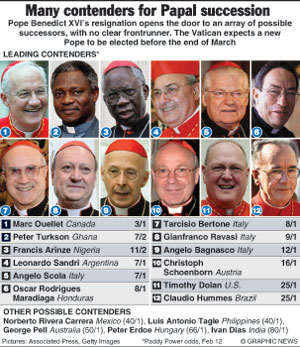Sunday Times 2
In uncharted retirement, Pope to live on at heart of Vatican
View(s):VATICAN CITY (Reuters) – Pope Benedict may be retreating into a life of prayer but the first retired pontiff since the Middle Ages will, physically at least, remain at the very heart of the Vatican. The convent of Mater Ecclesiae – Mother of the Church – is being renovated and following Benedict’s shock resignation will offer him a substantial, four-storey, modern home, complete with contemporary chapel, garden and a roof terrace looking out from a rise dominated by the Holy See’s TV transmission tower.
The 20-year-old, gated compound could hardly be more central to the 100-acre Vatican City, the microstate inside central Rome where Benedict will remain head of state until February 28; it lies barely 200 meters to the rear of St. Peter’s Basilica, where his successor may be consecrated next month, in time for Easter.

The monastery from where Pope Benedict XVI will retire from March 2013 is seen at the Vatican (REUTERS)
With even close aides confessing to surprise at the 85-year-old German’s decision to become the first pope in over 700 years to step down from leadership of the Roman Catholic Church, living as an ex-pope is uncharted territory – though cardinals insist there is no risk of Benedict meddling or undermining the infallible power accorded his successor, no risk of schism.
Such fears saw the last pope to retire, Celestine V, hunted down and arrested by his suspicious successor, a rival in the bitter factionalism of the mediaeval Church; confined to a tiny dungeon at a castle outside Rome, within months, Celestine died in 1296, hidden from the world and in hermit’s rags.
The fate of Benedict, once dubbed the “Prada Pope” for his taste in fine red loafers and haute-couture vestments, will be very different, although Church officials seem still themselves to be working out just what his new life in cloisters will be.
His initial departure from the grand papal apartments in the 16th-century Apostolic Palace, where he has spent eight years with a staff of clerical secretaries, including priests and nuns, a butler and other domestic staff, will be for the no less palatial surroundings of the historic summer residence of popes at Castel Gandolfo, on a lake in the hills south of Rome.
It seems likely he will stay there while the conclave of cardinals meets in the Vatican to elect his successor.
Renovation
Once renovation work is complete at Mater Ecclesiae, founded in 1994 as a convent for a succession of female monastic orders by Benedict’s predecessor John Paul II, the new pensioner will be able to move in. The nuns, who occupied up to 12 cells in the upper floors of the building, have moved out. Quite who else will live in the compound to serve the former pope is unclear.
Italian newspaper Corriere della Sera said the refurbishment had begun in November – at a time when, it seems, few if anyone in the Vatican had an inkling of what was on Benedict’s mind.
Also unknown is how the ex-pope will spend his time. In Monday’s resignation speech, he said only: “With regard to myself, I wish to also devotedly serve the Holy Church of God in the future through a life dedicated to prayer.”

He may write more of the books that, as Cardinal Joseph Ratzinger, earned him a reputation as a distinguished theologian of a conservative bent – a trait that also saw him dubbed “God’s Rottweiler” by liberals, some of whom fear he might remain a hidden obstacle within the Vatican to any reformist successor.
Vatican spokesman Father Federico Lombardi said on Tuesday: “I think it would be normal for him to start a new life in this sense: prayer, reflection; we hope also that he might write something. But this will depend on him.”
Benedict, whose very name may have to change in retirement along with his entitlement to the unique form of address Your Holiness, has said he lacks the mental and physical strength to continue leading the world’s 1.2 billion Roman Catholics.
Should he seek mild exercise, eggplant and zucchini grow in the convent’s vegetable patches next to orange and lemon trees whose fruit has been used in marmalade for his breakfast table.
Follow @timesonlinelk
comments powered by Disqus


















